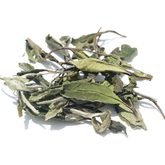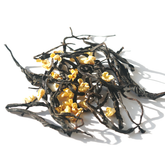What Is The Difference Between Black Tea And Green Tea?|NPTEA
Tea comes in a variety of types, but among the six major tea categories, black tea and green tea are the most popular. Although both types of tea come from the same plant, Camellia sinensis, they have significant differences in processing methods, flavor characteristics, and health benefits. This article will explore the key differences between black tea and green tea, including their definitions, brewing methods, and common varieties. By reading this article, you will gain a comprehensive understanding and be able to easily distinguish between black tea and green tea.
| Item | Black Tea | Green Tea |
| Oxidation Level | High (Fully fermented) | Low (Unfermented or lightly fermented) |
| Color | Dark red or brownish red | Green or pale yellow-green |
| Taste | Strong, sweet, with floral, fruity, and malty notes | Fresh, crisp, with grassy, nutty, and floral notes |
| Common Varieties | Keemun, Yunnan, Jin Jun Mei, Darjeeling, Assam, Ceylon Black Tea, Earl Grey | Longjing, Biluochun, Huangshan Maofeng, West Lake Longjing, Duyun Maojian, Anji White Tea |
| Health Benefits | Improves cardiovascular health, aids digestion, boosts immunity | Helps with weight loss, boosts metabolism, antioxidants, cancer prevention |
| Caffeine Content | High, typically 40-70 mg per cup | Low, typically 20-45 mg per cup |
| Cultural Influence | Very popular in Western cultures, especially in the UK and the US | Widely consumed in China, Japan, and other East Asian countries |
How to Easily Tell the Difference
Black tea and green tea have distinct differences in appearance, brew color, aroma, and flavor. By observing these characteristics, you can easily tell them apart:
Brew Color
Black Tea: The brew is a deep reddish-brown or amber color, with high transparency.
Green Tea: The brew is a light green or yellowish-green color, clear and bright.
Dry Leaf Color
Black Tea: The dry leaves are dark brown or black, often in strip or granular shapes.
Green Tea: The dry leaves are green or dark green, typically flat (like Longjing) or curly (like Biluochun).

What is Black Tea?
Black tea is the tea type with the highest oxidation level among the six major tea categories. It is named after its rich, deep red color. During the fermentation process, the polyphenol oxidase in the tea leaves catalyzes the oxidation of tea polyphenols, forming theaflavins and thearubigins, which give black tea its unique color and flavor. This is also the source of the deep color and bold taste of black tea. Black tea is highly popular in Western cultures, especially in the UK and the US.
Brewing Recommendations
Tea-to-water ratio: 1:25, for example, 6g of tea leaves for a 150ml teapot.
Water temperature: Black tea is generally brewed with water at 90°C to 100°C (194°F to 212°F) to fully release its aroma and flavor.
Tea ware: It is recommended to brew black tea using a gaiwan (盖碗) for better control over the steeping time.
Steeping time: The steeping time for black tea should not be too long. Steep for about 5 seconds to release the tea's flavor. Over-steeping can lead to a bitter taste. Subsequent steeps can be longer based on preference.
Processing Method
The production process of black tea includes several stages: withering, rolling, oxidation, and drying. The oxidation process gives black tea its deep color and bold flavor. During this process, the tea leaves are exposed to air, and the enzymes in the leaves react with oxygen, forming compounds that affect the taste and aroma.
Caffeine Comparison: Black Tea vs. Coffee
Each cup of black tea (approximately 240 ml) typically contains 40-70 mg of caffeine, while a cup of coffee (240 ml) contains approximately 95-200 mg of caffeine. The specific caffeine content varies depending on the tea variety. For example:
- Darjeeling Black Tea: Caffeine content is relatively high, about 50-70 mg per cup.
- Keemun Black Tea: Caffeine content is moderate, about 40-60 mg per cup.
Factors Affecting Caffeine Content:
- Tea grade: Younger leaves generally have a higher caffeine content than older leaves.
- Steeping time: The longer the steeping time, the more caffeine is released.
- Water temperature: Higher water temperatures increase caffeine extraction efficiency.
| Aspect | Black Tea (240 ml) | Coffee (240 ml) | Notes |
| Caffeine Content | 40-70 mg | 95-200 mg | Coffee contains significantly more caffeine than black tea. |
| Effect | Mild alertness, longer-lasting (4-6 hours). | Quick alertness, shorter-lasting (2-4 hours). | L-theanine in black tea mitigates caffeine's stimulant effects, providing a gentler boost. |
| Health Impact | Moderate consumption may improve focus and provide antioxidants; excess may cause insomnia. | Moderate consumption may enhance attention; excess may lead to palpitations or anxiety. | The safe daily caffeine intake is up to 400 mg (about 4-5 cups of coffee or 8-10 cups of black tea). |
| Suitable For | Ideal for caffeine-sensitive individuals or those seeking a mild energy boost. | Ideal for those needing quick focus or high-intensity work. | Choose based on personal needs and tolerance. |
Common Famous Chinese Black Tea Varieties
Keemun: From Anhui Province, Keemun black tea has a rich, smooth taste with floral and fruity notes, and is known as the "Queen of Black Teas."
Yunnan Black Tea: From Yunnan Province, this tea is full-bodied with a sweet taste, sometimes with subtle chocolate or honey notes.
Jin Jun Mei: A high-quality black tea from Fujian Province, with a sweet taste and natural honey aroma.
Darjeeling: Known as the "Champagne of Tea," Darjeeling black tea has a lighter taste with floral aromas.
Assam: A strong, malty black tea from India, commonly used in breakfast tea blends.
Ceylon Black Tea: From Sri Lanka, Ceylon black tea has a bright, citrus-like flavor.
Earl Grey: A blend of black tea and bergamot oil, which imparts a distinct citrus aroma.
What is Green Tea?
Green tea has a lower oxidation level, which helps it retain its green color and fresh flavor. Originating in China, it is widely loved for its delicate taste and health benefits. The production process of green tea is very simple, preserving the natural characteristics of the tea leaves.
Brewing Recommendations
Tea-to-water ratio: 1:40, for example, about 3.75g of tea leaves for a 150ml teapot.
Water temperature: Green tea should be brewed with lower temperature water, typically between 70°C and 80°C (158°F to 176°F), to avoid bitterness.
Tea ware: Green tea can be brewed in a regular glass cup or a lidded bowl (盖碗).
Steeping time: Green tea can be steeped for longer periods, but it is important to refresh the water in time, as the tea can become overly strong and bitter towards the end of the brew.
Processing Method
The processing of green tea mainly involves quickly heating or steaming the tea leaves to prevent oxidation. This process preserves the green color and fresh flavor of the tea. Unlike black tea, green tea is not rolled or oxidized, which helps retain a more delicate taste.
Caffeine Comparison: Green Tea vs. Coffee
Each cup of green tea (approximately 240 ml) typically contains 20-45 mg of caffeine. The exact caffeine content is influenced by factors like the tea variety, steeping time, and water temperature. For example:
- Longjing: The caffeine content is lower, about 20-30 mg per cup.
- Matcha: The caffeine content is higher, about 30-45 mg per cup, since it uses powdered whole tea leaves, allowing for better caffeine extraction.
Factors Affecting Caffeine Content:
- Tea grade: Younger leaves tend to have higher caffeine content than older leaves.
- Steeping time: The longer the steeping time, the more caffeine is released.
- Water temperature: Higher water temperatures improve caffeine extraction efficiency.
| Aspect | Black Tea (240 ml) | Coffee (240 ml) | Notes |
| Caffeine Content | 20-45 mg | 95-200 mg | Coffee contains significantly more caffeine than green tea. |
| Effect | Mild alertness, longer-lasting (4-6 hours). | Quick alertness, shorter-lasting (2-4 hours). | L-theanine in black tea mitigates caffeine's stimulant effects, providing a gentler boost. |
| Health Impact | Moderate consumption may improve focus and provide antioxidants; excess may cause insomnia. | Moderate consumption may enhance attention; excess may lead to palpitations or anxiety. | The safe daily caffeine intake is up to 400 mg (about 8-10 cups of green tea or 4-5 cups of coffee). |
| Suitable For | Ideal for caffeine-sensitive individuals or those seeking a mild energy boost. | Ideal for those needing quick focus or high-intensity work. | Choose based on personal needs and tolerance. |
Common Famous Chinese Green Tea Varieties
Longjing (Dragon Well): A famous Chinese green tea from Hangzhou, Zhejiang, known for its delicate sweetness and nutty aroma, with a clear tea soup and a refreshing taste.
Biluochun: From the area around Tai Lake in Jiangsu, this tea is known for its fragrant floral and fruity aroma and refreshing flavor. The leaves curl like a spiral.
Huangshan Maofeng: From Huangshan, Anhui, it has a fresh taste with sweet floral and subtle fruity notes. The tea soup is clear, and the aftertaste is lingering and sweet.
West Lake Longjing: From West Lake in Zhejiang, it is known for its refreshing fragrance, elegant flavor, and well-balanced sweet-bitter taste, often regarded as a representative of Chinese green tea.
Duyun Maojian: From Duyun, Guizhou, this tea has long, straight leaves and a fresh tea soup, with a grassy, floral flavor and a subtle sweetness.
Anji White Tea: Although named "white tea," it is actually a type of green tea from Anji, Zhejiang. It has a refreshing taste with a unique fresh aroma and sweetness.
Black Tea vs Green Tea: A Comparison
As the two most popular types of tea, black tea and green tea both originate from the same plant, the Camellia sinensis tea tree, but they differ significantly in terms of processing methods, flavor characteristics, brewing techniques, and health benefits.
Black tea undergoes full fermentation, resulting in a deep red liquor and rich flavor, making it ideal for those who enjoy a strong, robust taste. On the other hand, green tea preserves its natural green color and fresh flavor through a process called kill-green, which helps retain the natural qualities of the leaves. It is well-suited for those seeking a refreshing and healthy beverage.
The choice between black tea and green tea ultimately comes down to personal preferences and health needs. Black tea pairs well with breakfast or afternoon tea, while green tea is a great choice for daily consumption due to its light and refreshing taste.
FQA
1. What are the health benefits of black tea versus green tea?
Both teas contain antioxidants that support heart health and mental alertness, though green tea has slightly higher antioxidant content.
2. How should black tea or green tea be stored?
Store in airtight containers away from light, moisture, heat, and odors. Some tea enthusiasts seal their tea in attractive containers and display them in glass display cabinets while ensuring they remain protected from environmental factors.
3. What is the proper brewing temperature and time for each tea?
Green tea: lower temperature water (160-180°F/70-82°C) for shorter time (1-3 minutes). Black tea: hotter water (200-212°F/93-100°C) for longer steeping (3-5 minutes).
SEE MORE CHINESE TEAS
If you have questions about selecting tea:
Learn-more-about-chinese-tea
If you have questions about the benefits of tea:
Health-benefits-of-chinese-tea
If you have questions about brewing tea:
How-to-brew-loose-leaf-tea






